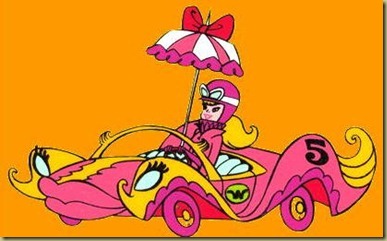 Yo nunca me he interesado en los carros, nunca he entendido el apego que sienten algunas personas por los suyos y no entiendo cómo son objeto de tantas fantasías y aspiraciones. La gente que tiene carros gigantes y ostentosos me parecen unos ridículos que han de tener que compensar por algún defecto y que además viven desconectados de la realidad de un país en crisis y con calles incómodas. Pero desde hace algunas semanas mi absoluta indiferencia hacia estos artefactos ha estado desvaneciéndose. Sólo basta decir que hoy soy capaz de decir que mi carro es un Toyota Celica del 2002 en lugar de “uno gris” como lo describía antes. Y es que me he encariñado con ese montón de metal desde que él y yo convivimos hasta por más de una hora al día, prácticamente todos los días.
Yo nunca me he interesado en los carros, nunca he entendido el apego que sienten algunas personas por los suyos y no entiendo cómo son objeto de tantas fantasías y aspiraciones. La gente que tiene carros gigantes y ostentosos me parecen unos ridículos que han de tener que compensar por algún defecto y que además viven desconectados de la realidad de un país en crisis y con calles incómodas. Pero desde hace algunas semanas mi absoluta indiferencia hacia estos artefactos ha estado desvaneciéndose. Sólo basta decir que hoy soy capaz de decir que mi carro es un Toyota Celica del 2002 en lugar de “uno gris” como lo describía antes. Y es que me he encariñado con ese montón de metal desde que él y yo convivimos hasta por más de una hora al día, prácticamente todos los días. Una de las cosas que más extraño de Europa es tener la posibilidad de comprar cualquier libro en cualquier momento y que me llegue directo al buzón en unos cuantos días. No sólo por tener la facilidad monetaria de poder comprar casi todo lo que se me antojara, sino que allá no hay límites a lo que se puede conseguir. Regresé a una Tegucigalpa donde las librerías son unos negocios raquíticos y lastimeros que subsisten únicamente gracias a la venta de best-sellers. Y como uno de mis remedios para la tristeza es comprar libros me vi en la penosa necesidad de comprarme un libro popular. Escogí “Fifty shades of Grey” porque tengo meses de escuchar de él por todas partes y me dije que tiene que tener algo de rescatable para que un libro erótico haya dado el crossover hacia la lista de los más vendidos. Resumiendo la letanía que estoy por comenzar: es una completa basura y su popularidad es la confirmación más evidente de la estupidez de la cultura occidental.
Esta es la historia de Anastasia Steele, una joven de 21 años a punto de graduarse de la universidad que por una casualidad se encuentra frente a frente al guapísimo y multimillonario Christian Grey, haciéndole una entrevista para el periódico estudiantil. Ambos quedan flechados y Grey empieza a seducir a Ana con el fin de proponerle el único tipo de relación de la que es capaz: una en la que él tiene el absoluto control de su pareja – que exige con la firma de un contrato – desde los aspectos más triviales de la existencia como la forma en que se viste y lo que come, pero especialmente en exigir sumisión total cuando están juntos, algo que no sería tan difícil si Grey no tuviera una ligera adicción por los implementos masoquistas. ¿El dilema de esta proposición? Ana es virgen y por ende no tiene ningún patrón con el cual analizar lo descabellado o no de esta iniciativa. Sin embargo se siente inexplicablemente atraída por Grey y lo empieza a considerar.
Cuando empecé a leer el libro lo primero que noté fue la sorprendente semejanza de los personajes con otros del universo literario de la plebe: Bella Swan y Edward Cullen. Una joven inexperimentada de padres divorciados, socialmente torpe, insegura y un muchacho guapo, exageradamente guapo, repetitivamente guapo, como las autoras nos lo pasan martillando una y otra vez. Sólo que se remplaza el misterio de lo sobrenatural de Cullen por la cantidad exorbitante de dinero de Grey, algo que en la vida real es totalmente equivalente a ser un vampiro. Luego me enteré que la semejanza era en realidad una derivación pues “Fifty shades of Grey” comenzó siendo un relato nacido de “Twilight”, usando los mismos personajes de la novela original pero en una situación alterna. E.L. James, la autora de “Grey” pronto se dio cuenta que podía capitalizar su historia por su propia cuenta y decidió separarla del universo vampírico, pero no de todo lo demás. Para decir que hasta se queda siempre dentro del registro de lugares fríos y lluviosos, sólo que pasa de Forks a Seattle.
El concepto del libro no es malo, pero la ejecución, el estilo de la escritora y el espectro de su vocabulario es vergonzosamente pobre. A tal grado que me pregunto qué tipo de editor lo habrá leído y habrá visto potencial en algo que parece redactado por una adolescente a la que no le gusta leer más allá de la ocasional revista para mujeres. Al libro se le tilda de “Mommy porn” ya que la autora es una ama de casa de más de cuarenta años que de repente se convirtió en escritora, pero siento que este apelativo es insultante para las madres y para las mujeres maduras. Quiero pensar que cuando uno llega a cierta edad se alcanza un grado de exigencia y sofisticación que este libro ni siquiera aspira a tener. Ana y Christian no tienen personalidad, nada los caracteriza aparte de su juventud y supuesta belleza. Las situaciones son vacías, irreales, ridículas y a pesar que la literatura es el reino de lo improbable tampoco hay que subestimar a tal grado la inteligencia del lector. El libro no es erótico sino pornográfico y no hablo de las escenas de sexo, me refiero a los escenarios que sólo son malas excusas para justificar un encuentro, me refiero a las fantasías absurdas como tener un hombre perfecto que te compre un carro, una computadora Apple, un Blackberry y un guardarropa dos semanas después de conocerte y que te quiere obligar a que tengas un entrenador privado y que comas sanamente. Este es el verdadero escapismo, la justificación de añorar ser sumisa: tener a un tipo que te arregle la vida para no tener que hacerlo uno misma.
Cuando pienso que “Ivanhoe” se podría considerar como un best-seller de su época no puedo evitar decirme que “Grey” es el síntoma más reciente de la decadencia de nuestra generación. Nosotros seremos recordados por nuestras franquicias literarias para perezosos que en realidad no les gusta leer. Los Twilights, los Greys, las comidas rápidas de las lecturas. La gente debe dejar de engañarse, el que estos libros supuestamente inciten a la gente a leer buenos libros no sólo es falso sino que además no es un mérito. Leer estas cosas no cultiva a nadie, no enriquece el horizonte, no despierta ningún intelecto. Este es un engranaje más en la maquinaria que fabrica robots que no piensan, que no cuestionan, desprovistos de aspiraciones que trasciendan trabajar para consumir, para lucir, para enriquecer a un montón de explotadores en este mundo donde el individuo no vale nada, donde uno es un número más entre un millón. En esta sociedad de imbéciles.
E.L. James debería tomar más de una lección de Ayn Rand, autora de una de las escenas eróticas más brillantes que he leído. Se encuentra en “Atlas shrugged”, cuando Dagny Taggart y Hank Rearden finalmente se acuestan en el vagón de un tren. Después de reconocerse el uno al otro como personas con la misma visión de la vida, los mismos valores y aspiraciones, al darse cuenta que ellos dos están solos frente al mundo, que saben que están a años luz de los demás, que se respetan y que es casi un milagro que se hayan encontrado en medio de tanta mediocridad. Es hasta ese momento que finalmente ceden a sus impulsos. Pues el sexo es más que simplemente acostarse con alguien, es querer poseer su genio, es reconocer que es digno de ser admirado, es rendir tributo a su intelecto. Pues cuando los personajes ni siquiera tienen intelecto que justifique su existencia, no hay nada que sus cuerpos puedan hacer que valga la pena ser contado. Hace poco vi una entrevista con James, en la que decía que este libro lo escribió para ella. Tal vez ella debió habérselo quedado y no mostrárselo a nadie más. ¿Dónde están los profesores represivos cuando se les necesita?
One of the things I miss the most about Europe is having the possibility of buying any book at any time and having it delivered directly to my mailbox just a few days later. Not only because I had the financial capacity of buying almost anything I wanted but the fact that there are no limits to what you can find there. I came back to a Tegucigalpa where the bookshops are skimpy and pitiful businesses which subsist thanks only to the selling of best-sellers. And since one of my remedies for sadness is to buy books I found myself in the necessity of buying a popular book. I chose “Fifty shades of Grey” because I’ve been hearing about it everywhere and I thought it must be good since it is an erotic book who managed to crossover to the most sold books list. Summarizing the litany I’m about to begin: it is complete garbage and its popularity only confirms the evident stupidity of western culture.
This is the story of Anastasia Steele, a girl in her early twenties about to graduate from university who by coincidence finds herself in front of the handsome and multimillionaire Christian Grey, interviewing him for the student newspaper. They are both smitten by each other and Grey starts seducing Ana in order to offer to her the only kind of relationship he is capable of: one in which he has the absolute control of his partner – he demands so by the signing of a contract – from the most trivial aspects of everyday life like the way she dresses to what she eats, but especially in demanding utter submission when they’re together, something that wouldn’t be so hard if Grey didn’t have a slight addiction to masochist implements. The dilemma in this proposition? Ana is still a virgin and therefore has no standard to which analyze the craziness or lack thereof of this initiative. However, she feels inexplicably attracted to Grey and starts considering it.
When I started reading the book the first thing I noticed was the character’s outstanding resemblance to others from the literary universe of the populace: Bella Swan and Edward Cullen. An inexperienced young girl from divorced parents, socially awkward and insecure and a handsome young man, incredibly handsome, repeatedly handsome, as the authors keep hammering on again and again. The only difference is that the Cullen’s supernatural mystery is replaced by the exorbitant amount of money Grey has, something that in real life is totally equivalent to being a vampire. I later found out that the resemblance was in reality a derivation since “Fifty shades of Grey” started as story born out of “Twilight”, using the same characters from the original novel but in an alternate situation. E.L. James, “Grey’s” author, soon figured the possibility of capitalizing on her own story and decided to separate it from the vampire universe, but not from the rest. It even stays in the register of taking place in cold and rainy places, changing Forks for Seattle.
The concept of the book is not so bad, but the execution, the writer’s style and her vocabulary spectrum is shamelessly poor. It makes me wonder what kind of editor must have read it and seen potential in something that seems to have been written by a teenager who doesn’t like to read beyond the occasional women’s magazine. The book is said to be “Mommy porn” since the author is a housewife beyond her forties who suddenly became an author, but I find this appellation to be insulting to mothers and mature women. I want to think that when you reach a certain age you attain a certain level of demands and sophistication this book doesn’t even aspire to have. Ana and Christian lack any personality; nothing characterizes them beyond their youth and supposed beauty. The situations are empty, unreal, ridiculous and even though literature is the realm of the unlikely there is no reason to underestimate the reader’s intelligence to this point. The book is not erotic but pornographic and I’m not talking about the sex scenes, I’m referring to the scenarios which are just bad excuses to justify an encounter, I’m speaking of the absurd fantasies like having a perfect man buying you a car, an Apple computer, a Blackberry and an entire wardrobe after just two weeks of meeting you and who wants to force you to have a personal trainer and eating healthy. This is the real escapism, the justification of longing to be submissive: having a guy fix up your life for you so you don’t have to do it yourself.
When I think about the fact that “Ivanhoe” could be considered a best-seller of its time I can’t help thinking that “Grey” is the most recent symptom of our generation’s decadence. We will be remembered for the literary franchises for the lazy people who actually don’t like to read. The Twilights, the Greys, the fast-food of reading. People should stop fooling themselves, the fact that these books supposedly inspire people to read good books not only is false but it is no merit whatsoever. Reading this stuff doesn’t cultivate anyone, it doesn’t expand your horizon and it doesn’t awaken any intelligence. This is just another gear in the machinery which produces unthinking robots who don’t question, who are devoid of any aspiration that transcend working for consuming, for showing off, for making even richer a bunch of exploiters in this world where the individual is worth nothing, where you are just one amongst a million. In this society of imbeciles.
E.L. James should take more than one lesson from Ayn Rand, author of one of the most brilliant erotic scenes I’ve ever read. It can be found in “Atlas shrugged” when Dagny Taggart and Hank Rearden finally sleep together in a train wagon. After recognizing one another as people with the same vision in life, the same values and aspirations, after realizing that they are both alone against the world, when they know they are light years away from the rest of the people, that they respect each other and it’s almost a miracle that they found themselves in the midst of all this mediocrity. It is up until that point that they finally give in to their impulses. For sex is more just that getting laid with someone else, it’s wanting to possess his genius, it’s recognizing he is worthy of being admired, it’s a tribute to his intellect. But when the characters don’t even have intellect that could justify their existence, there is nothing their bodies could do that could be worth writing about. Not long ago I saw an interview with James, in which she said that she wrote this book for her. Maybe she should have kept it for herself and not show it to anyone else. Where are the repressive teachers when you need them?
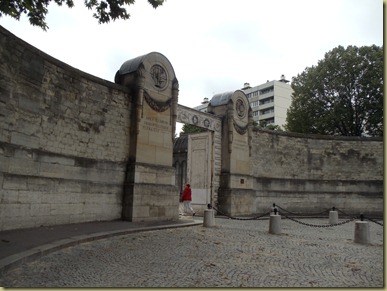 El recorrido que hicimos mi madre y yo al cementerio del Père Lachaise fue una de esas visitas que se hacen con un propósito que termina siendo completamente decepcionante pero sorprendente por otras razones. Fuimos por la petición de mi padre que tomáramos una foto de la famosa tumba de Jim Morrison, un bloque de concreto que en otro lugar hubiera bastado para impresionarme; varios me han dicho que no se necesita mucho para eso. Sin embargo, el cementerio está lleno de tantas joyas que esa tumbita en cuestión está lejos de ser lo más interesante allí. El Père Lachaise alberga mucha gente famosa, escritores, artistas, políticos, cantantes, varios venidos de todas partes del mundo que hacen que uno podría pasar horas y horas recorriéndolo como un macabro paseo de la fama. Pero lo que me encantó y me hizo entender lo conocido del lugar es el eclecticismo de las tumbas, algunas extremadamente elaboradas, kitsch y a pesar que todas son distintas logran crear un contexto harmonioso con toda la variedad.
El recorrido que hicimos mi madre y yo al cementerio del Père Lachaise fue una de esas visitas que se hacen con un propósito que termina siendo completamente decepcionante pero sorprendente por otras razones. Fuimos por la petición de mi padre que tomáramos una foto de la famosa tumba de Jim Morrison, un bloque de concreto que en otro lugar hubiera bastado para impresionarme; varios me han dicho que no se necesita mucho para eso. Sin embargo, el cementerio está lleno de tantas joyas que esa tumbita en cuestión está lejos de ser lo más interesante allí. El Père Lachaise alberga mucha gente famosa, escritores, artistas, políticos, cantantes, varios venidos de todas partes del mundo que hacen que uno podría pasar horas y horas recorriéndolo como un macabro paseo de la fama. Pero lo que me encantó y me hizo entender lo conocido del lugar es el eclecticismo de las tumbas, algunas extremadamente elaboradas, kitsch y a pesar que todas son distintas logran crear un contexto harmonioso con toda la variedad. 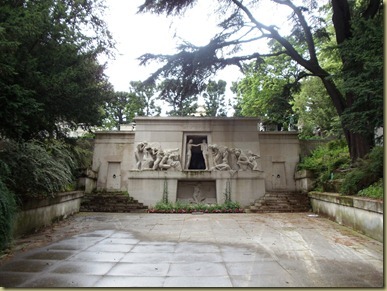
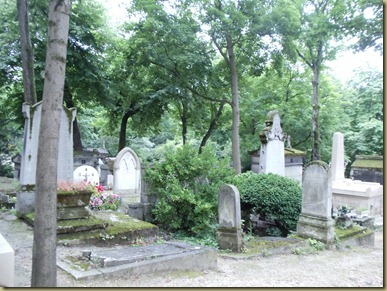
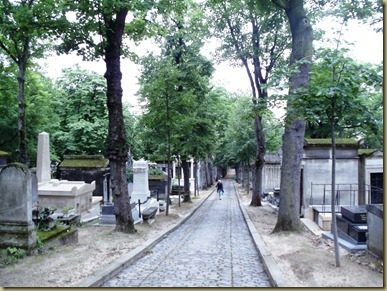
Chopin:
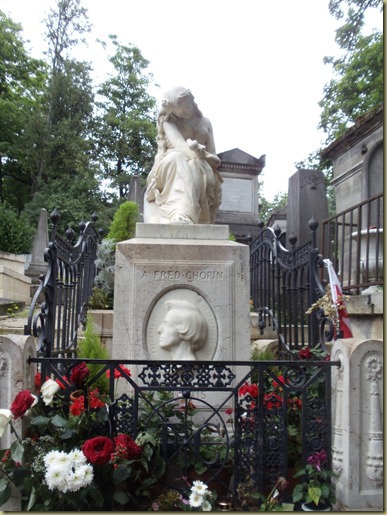

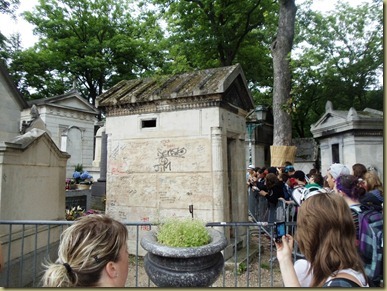
Jim Morrison:

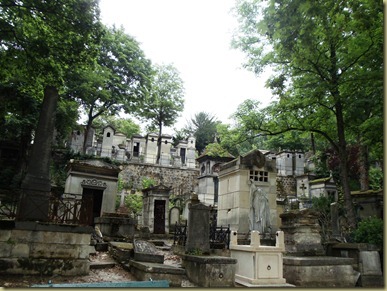

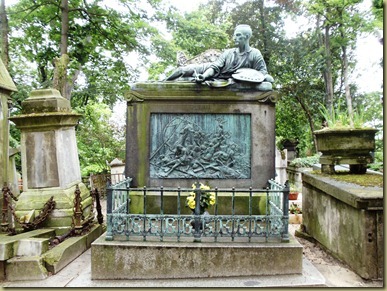
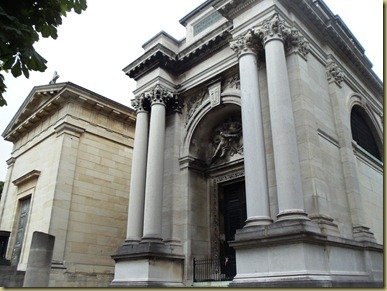
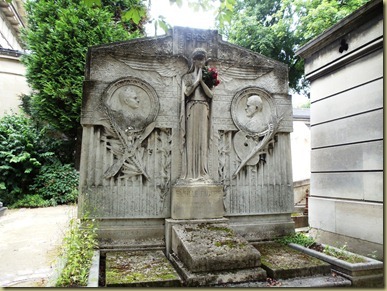
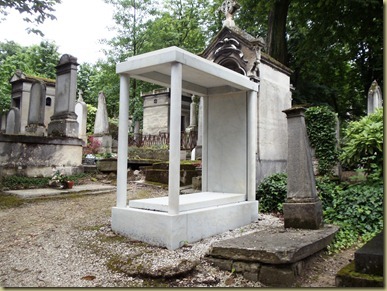
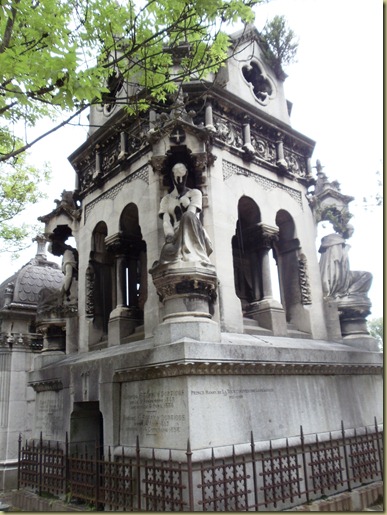
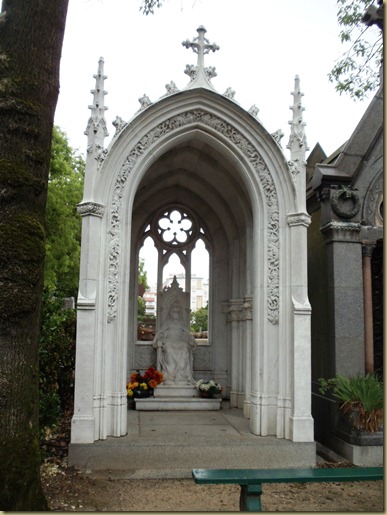
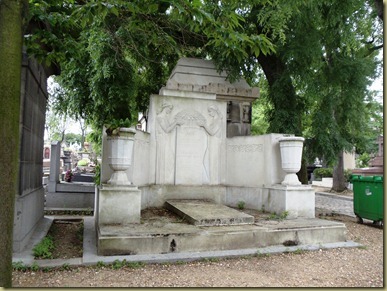
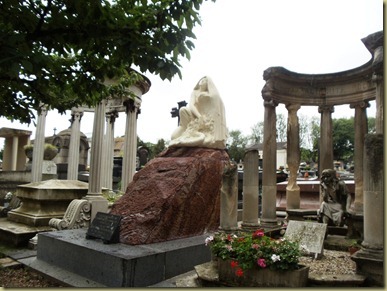
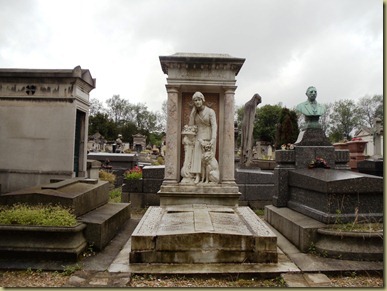
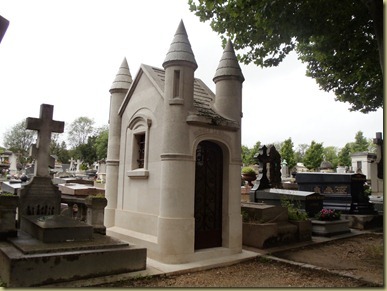
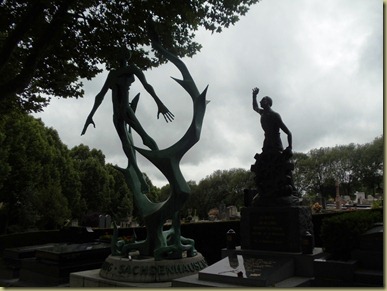
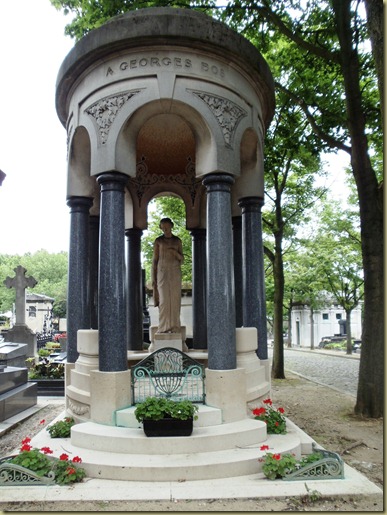
Edith Piaf:
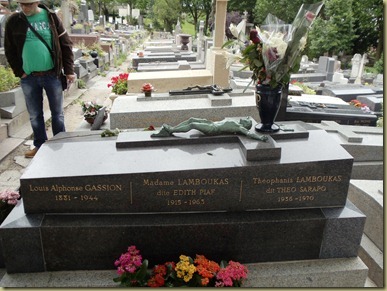
Oscar Wilde:
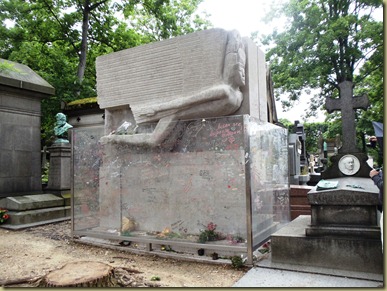
El primer tomo de una serie de más de seis volúmenes de la autobiografía de Simone de Beauvoir es probablemente el libro que más he querido y que más me haya impactado en diez años, desde la primera vez que lo leí. La razón es sencilla: nunca antes me había sentido tan identificada con un personaje de libro. En cada párrafo, con cada experiencia que Simone relata sentía que hablaba de mí, que ella pudo decir lo que yo nunca me atreví o nunca fui capaz. Obviamente, no puedo comparar vivir en Tegucigalpa con vivir en París, ni siquiera París a principios del siglo XX (probablemente ni con París en la Edad Media), pero lo maravilloso de este libro es que la prioridad de Simone en este tomo es su vida interior, a falta de cualquier contacto real con el mundo externo. Su universo es reducido, están sus padres, su hermana menor, su mejor amiga, su colegio católico, en los primeros años la muchacha que trabaja en su casa. Por fuera su vida oscila entre el tedio de la vida académica y la represión de la vida familiar. Pero por dentro es infinita, está llena de historias gracias a todos los libros que lee, de teorías por las cosas que estudia y que piensa, por dentro Simone es libre de toda autoridad y convención.
Simone fue una niña obediente, como el título de su libro lo afirma. Fue una niña muy bien portada, muy alegre y despreocupada, que confiaba en el buen juicio de sus padres, profesores y de ese Dios cristiano que le enseñaron a venerar. No hay mucha necesidad de cuestionar el orden de las cosas cuando se está pequeño pero más que eso, al inicio uno se ve cegado por la admiración y el cariño hacia los mayores. La máxima felicidad es complacerlos y la imagen personal se distorsiona o se aclara a través del lente de los otros. Pero en la adolescencia todo cambia y esta es una transición que se siente de manera natural en el libro. Los pedestales en los que los adultos reposaban gracias a la ingenuidad infantil se van desmoronando uno a uno. El primero que cae es la divinidad, esa abstracción de ser superior, protector y castigador que desaparece por puro tecnicismo. La opresión de su casa la obliga a adoptar una vida clandestina de salidas, libros y pensamientos reprensibles por su medio. Es el único escape que encuentra, es lo que le permite tolerar el paso de los días. Pero si esa vida no le plantea ninguna culpa, si desobedecer a Dios no le causa remordimiento es que Dios entonces no ha de existir para ella.
El mundo de los adultos se revela como el de seres dominados por la monotonía, la mediocridad, la repetición viciada de actividades y opiniones. A eso Simone le opone una férrea creencia en su vocación, su deseo de crear una obra que justifique su vida, que la separe de los anónimos y de los inútiles. Su trascendencia no puede venir de la perpetuación de la especie: encuentra más mérito en escribir un libro, algo que requiere talento, esfuerzo y una voz única, que en tener un hijo, algo que cualquiera, hasta los que menos deberían tenerlo, son capaces de. Y es a esta obra que va a dedicar entonces su vida, es por ella que va a ser una excelente alumna, ya que su escapatoria, su boleto para la independencia son sus estudios.
Los siguientes en perder el aura de invencibilidad son los padres. Con el tiempo estos se muestran como lo que son, seres imperfectos, que como cualquier otro van caminando a ciegas en la incertidumbre teniendo como única arma su propio pasado y es por eso que apenas pueden ver lo que tienen enfrente. Simone los describe sus padres con una distancia impresionante, como si se tratase de un doctor analizando un paciente, con una frialdad que llega a parecer cruel. Se da cuenta que si no estuviera atada a ellos por la impotencia de la edad estos son seres con los que no tendría relación alguna por voluntad propia. Tiene una mejor amiga que se somete ciegamente a las exigencias absurdas de su madre; su amiga sufre de contrariarla, se culpa por juzgarla. Simone se da cuenta que no sólo juzga a sus propios padres de manera implacable, sino que tampoco se siente mal por ello. Su vida entera se construyó posteriormente de manera a no repetir la vida que ellos tuvieron, a no casarse sin amor para ser una ama de casa frustrada dependiente de un marido obligado a trabajar en algo que le disgusta sólo para aparentar estar en bonanza económica. Simone decidió rápidamente que ella trabajaría para no rendirle cuentas a nadie, sea una pareja o la sociedad misma. Decidió desde muy joven que nunca olvidaría esos primeros años cuando más adelante fuera una adulta.
Y es por eso que me resulta tan difícil leer este libro ahora, como lo fue hace diez años. Porque todavía soy como la Simone que todavía no se ha emancipado, porque tengo que vivir de mis proyectos, de mi deseo de crear una obra futura para soportar la estupidez de mi cotidiano. Porque sé que hay una salida, porque logré salir por un tiempo, pero fui muy cobarde para asumir la incertidumbre. Pero Simone logró salir y nunca más regresó y yo no he de cometer el mismo error dos veces.
The first tome in a series of more than six volumes of Simone de Beauvoir’s autobiography is probably my most beloved and most shocking book I’ve read in the last ten years, since the first time I read it. The reason is very simple: I’ve never felt so identified with a character in a book. In each paragraph, with each experience Simone narrates I felt she was talking about me, that she managed to say what I never dared or was never able to. Obviously, I can’t compare living in Tegucigalpa with living in Paris, not even Paris in the beginning of the XXth century (probably not even Paris in the Middle Ages), but the wonderful thing about this book is that Simone’s priority in this volume is her inner life, for lack of any real contact with the outside world. Her universe is reduced; there are her parents, her little sister, her catholic school, during the first years the young woman who works at her home. Outside her life oscillates between the tedium of academic life and the repression of family life. But on the inside it is boundless, it is filled with stories thanks to all of the books she reads, of theories thanks to the things she studies and thinks, on the inside Simone is free from all authority and convention.
Simone was an obedient little girl, like the title of the book declares. She was well-behaved, very happy and careless, trusting in the good judgment of her parents, teachers and that Christian God she was taught to worship. There is no much need to question the order of things when you’re little but more than that, at first you’re blinded by the admiration and the love for the elders. The greatest happiness is pleasing them and personal image is distorted or clarified through the lens of the others. But in adolescence everything changes and this is a transition which feels natural in the book. The pedestals in which adults used to lay thanks to childish ingenuity tumble down one by one. The first to fall is the divinity, that abstraction of a higher being, protector and punisher who fades away on a technicality. The oppression of her home forces her to adopt a clandestine life of books and thoughts reprehensible according to her surroundings. This is the only escape she finds; it is what enables her to tolerate the passing of the days. But if that life causes her no guilt, if disobeying God causes her no regret, God must not exist for her.
The adult world reveals itself to be full of beings dominated by monotony, mediocrity, by the vicious repetition of activities and opinions. To that Simone opposes a strong belief in her calling, her desire to create a work that will justify her life that will set her apart from the anonymous and the useless. Her transcendence cannot come from perpetuating the species: she finds more merit in writing a book, something that requires talent, effort and a unique voice, than in having a child, something that anyone, even those who shouldn’t, are able to have. And to this work she will then dedicate her life, it’s for this work that she will be an excellent student, since her way out, her ticket to independence are her studies.
The next ones to lose the invincibility aura are her parents. With time these show themselves as they are, imperfect beings that like anyone else wander blindly in the uncertainty having as sole weapon their own past which is why they barely can see what they have in front of them. Simone describes her parents with an impressive distance, like a doctor analyzing a patient, with a coldness which can seem cruel. She realizes that if she weren’t bound to them by the helplessness of age these are beings with which she wouldn’t have any relationship on her own will. She has a best friend who blindly submits to the ridiculous demands of her mother; her friend suffers for going against her mother’s wishes, she blames herself for judging her. Simone comes to realize that she not only judges her own parents in a merciless way but that she doesn’t feel bad for it. Her whole life was then built so as to not repeat the life they had, so that she didn’t have to marry without love in order to become a frustrated housewife dependent on a husband forced to work in something he dislikes just to appear to be in an economic bonanza. Simone quickly decided she would work so she didn’t have to answer to anyone, be it a partner or society itself. She decided early on that she would never forget these first years when she would later become an adult.
And this is why it’s so hard for me to read this book now, as it was ten years ago. Because I am still the non-emancipated Simone, because I have to live off of my projects, of my desire to create a future work to resist the stupidity of my daily life. Because I know there is a way out, because I managed to get out for a while but I was to coward to assume the uncertainty. But Simone managed to leave and she never came back and I won’t make the same mistake twice.
A pesar de que podría pasar el resto del año escribiendo sobre la Bretagne, es el momento de terminar de mostrar lo que he podido visitar en esta región. Empecemos por Lorient, una ciudad que me pareció muy moderna, audaz y elegante. Puede ser sobria, como se puede ver en la simplicidad de los volúmenes de uno de sus colegios, pero puede ser excéntrica cuando quiere, como se puede ver en el teatro de la ciudad. Me gustó mucho caminar por las calles, pero mi lugar preferido es sin lugar a dudas la iglesia Notre-Dame-de-Victoire. Sólo con verla uno puede saber que es de los años cincuenta y todo me encantó en ella: su austeridad en la exposición de concreto y bloque visto, sus dimensiones grandiosas, su versión contemporánea de vitrales y la decoración en su altar. Esta iglesia debería reivindicar la ciudad entera a los ojos de quienes no la quieren por haber sido reconstruida después de la guerra.
In spite of the fact that I could spend the rest of the year writing about Brittany, it is time to finish showing what I could visit of this region so far. Let’s begin with Lorient, a city I found to be modern, edgy and elegant. It can be sober, as it can be seen in the simplicity of the volumes of one of its high schools, but it also can be eccentric when it wants to be, as you can see in the city’s theater. I liked very much wandering in the streets but my favorite place definitively has to be the Notre-Dame-de-Victoire church. Just by looking at it you can know it was built in the 50’s and I loved everything about it: its austerity by showing exposed concrete and block, its grandiose scale, its contemporary version of stained-glass windows and the decoration in the altar. This church alone should make up for the whole city in the eyes of those who don’t love it just for being rebuilt after the war.
De Rennes no conocí mucho, excepto la zona más importante para todos los estudiantes: la “rue de la soif”, la calle de la sed, donde están todos los bares y donde se llena los jueves en la noche de jóvenes borrachos y relajeros. No pude apreciar este espectáculo, pero sí me pude tomar una cerveza allí, antes de ir a caminar por el centro a ver las casitas en las que me imagino que pudo haber vivido Hansel y Gretel.
I didn’t visit Rennes very much except for the most important zone for students: the “rue de la soif”, Thirst Street, where all the bars are and where every Thursday night it gets filled by young and noisy drunks. I couldn’t witness that scene but I did have a beer there, before walking around the city’s center to see all the little houses where I imagine Hansel and Gretel could have lived.
Y finalmente Quimper, donde uno puede sentir que se viaja a la Edad Media por un momento, especialmente por su hermosa e impresionante catedral. Era nuestra última noche en Bretagne y por eso decidimos cenar en una crepería tradicional por última vez. Aprovecho entonces para mostrar lo que es una verdadera crepa bretona. En realidad, crepas son las dulces ya que cuando son saladas se llaman “galettes”. Uno de sus ingredientes es el trigo harinero, que le da ese color oscuro. Son muy grandes y una de las recetas más comunes es con queso, pedacitos de tocino y un huevo. Generalmente se acompañan con cidra. Pues a mi regreso a Honduras decidí ir a comer a una crepería local que ya conocía antes y me pareció muy divertido darme cuenta que lo que yo creía que era una crepa no podía estar más alejado de la realidad. O tal vez sólo sea adaptación al mercado. Aunque yo creo que las verdaderas crepas serían un éxito en Honduras.
And finally Quimper, where you can feel yourself going back to the Middle Ages for a while, especially because of its magnificent cathedral. It was our last night in Brittany and we decided to have dinner in a traditional crêperie one last time. I want to show then what a real crêpe from Brittany looks like. Actually, crêpes are the sweet ones and the salty ones are called “galettes”. One of its ingredients is common wheat which gives them their dark color. They are very big and one of the most common recipes includes cheese, bits of bacon and an egg. You normally drink cider with it. So when I came back to Honduras I decided to eat at a local crêperie I knew before and it was very funny to see that what I believe was a crêpe couldn’t be further away from the truth. Or maybe it’s just adaptation to the local market. But I have a feeling real crêpes would be hugely successful in Honduras.
Crepas hondureñas/Honduran crêpes:
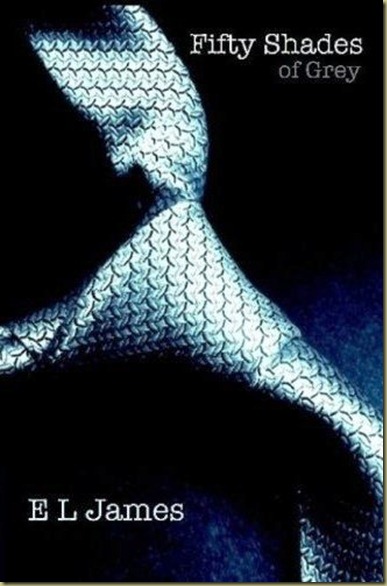



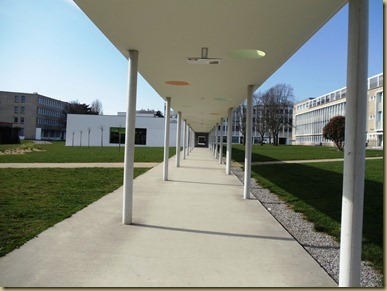



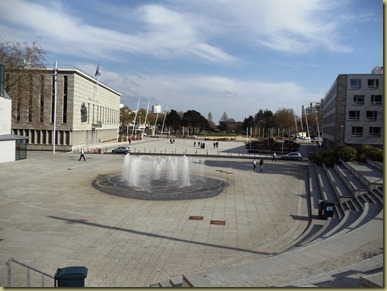

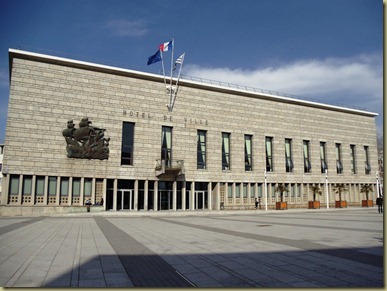
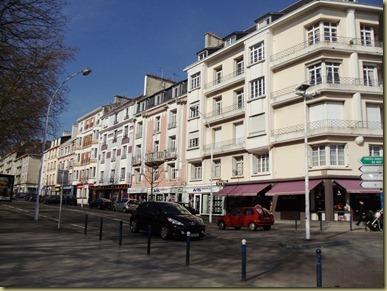
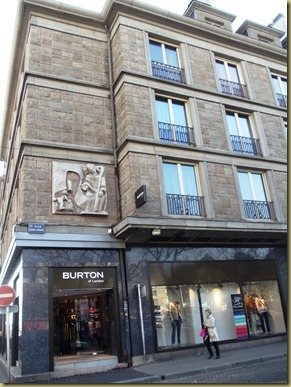

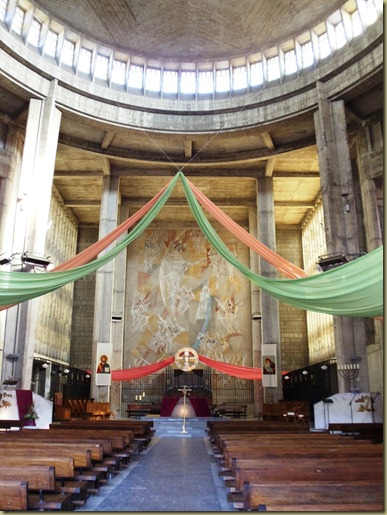
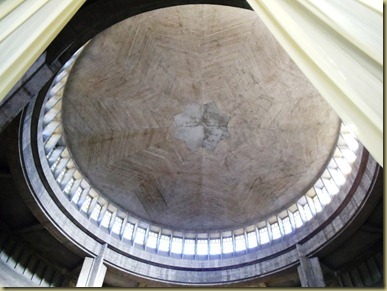
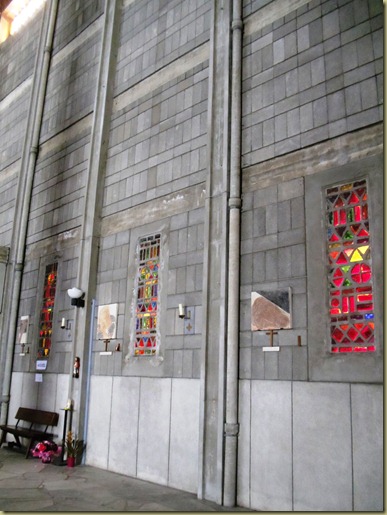


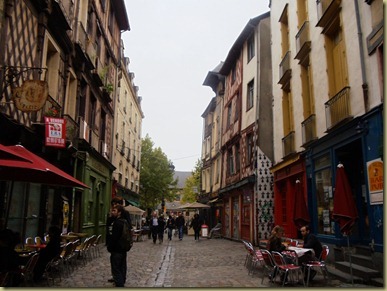
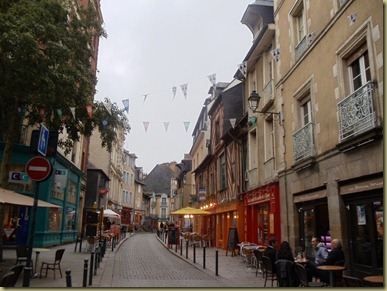
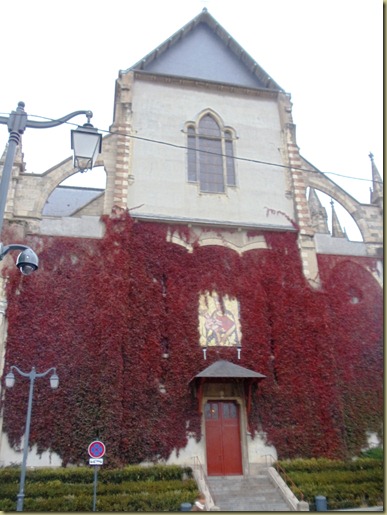
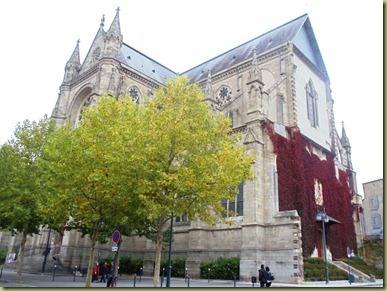
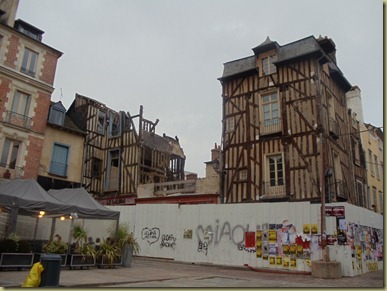

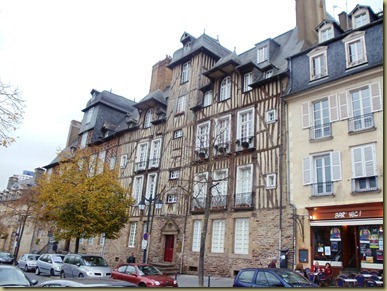


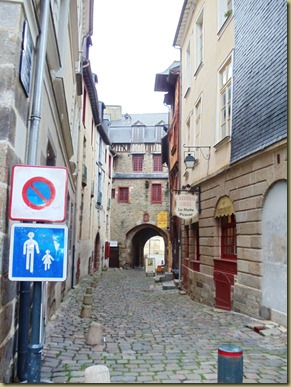
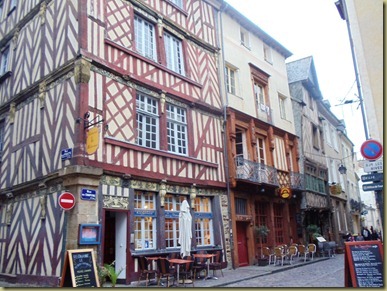
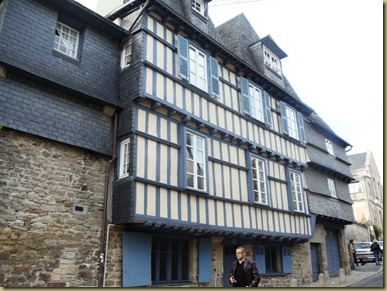
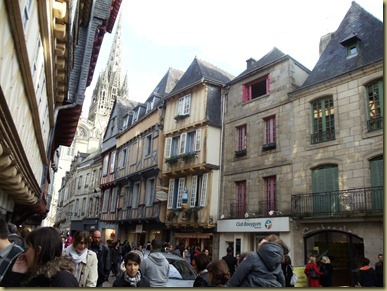
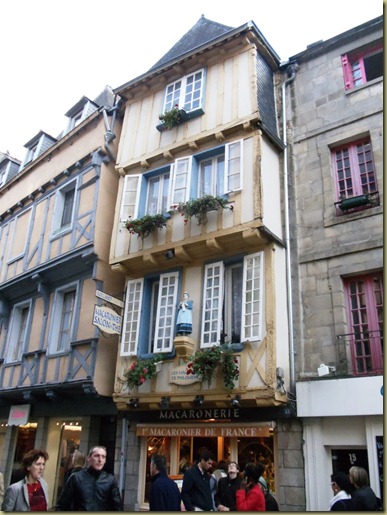
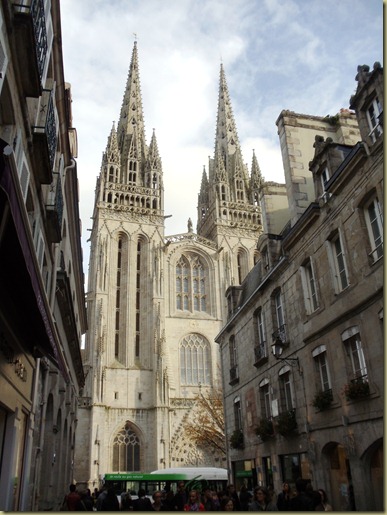

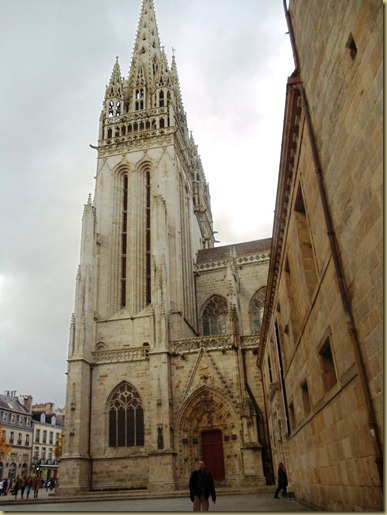
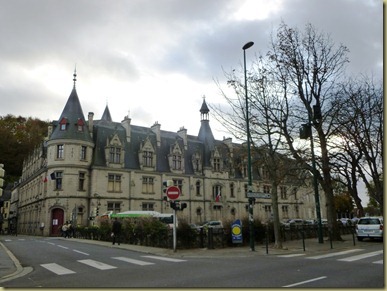

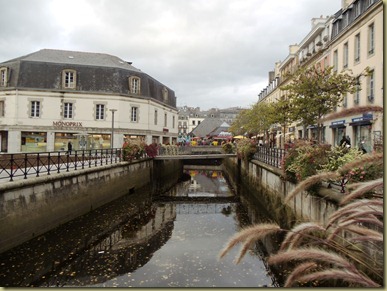
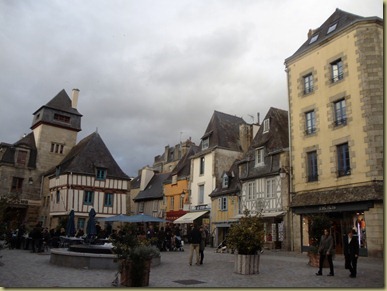
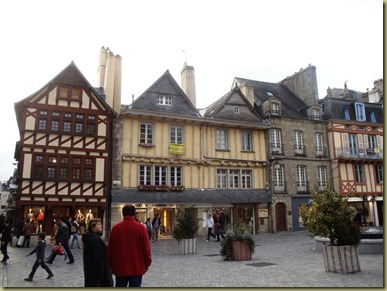

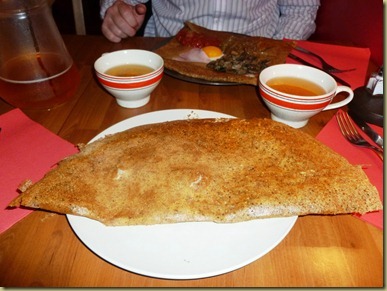
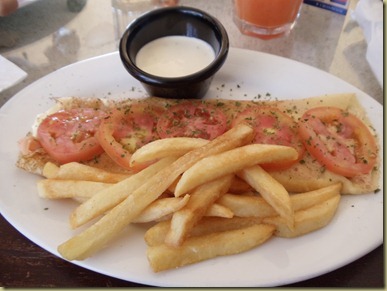
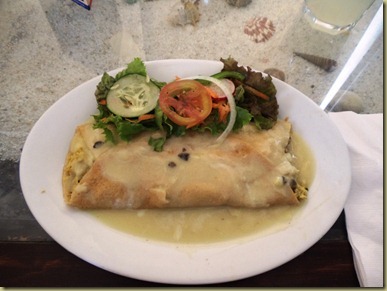
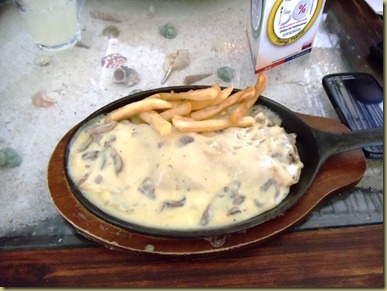


Social Icons